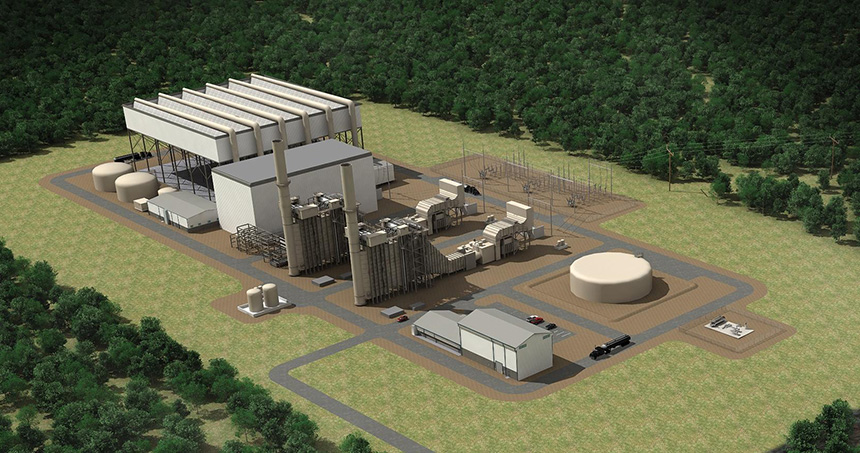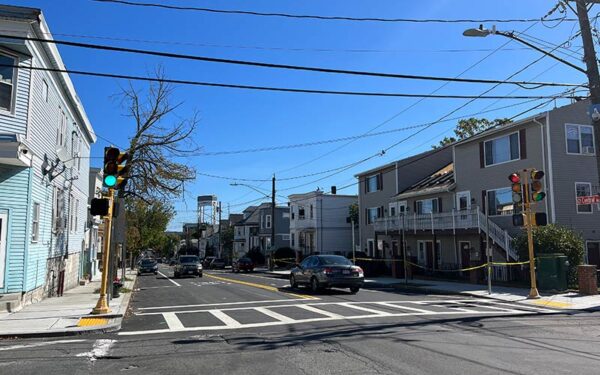
Invenergy says that New England needs its proposed power plant to ensure we have plenty of electricity in the future. Yet for three years in a row, our region's capacity auction has shown just the opposite. Photo: Invenergy
The ISO’s Forward Capacity Auction 12, conducted on Monday, February 5, 2018, once again shows that the proposed Invenergy fracked gas and diesel oil power plant is not needed.
What Is the Forward Capacity Auction?
The Independent System Operator-New England (ISO) is the entity that runs the New England electricity grid. The ISO is regulated under federal law and is responsible for ensuring that there is always enough electricity on the New England power grid to keep the lights on. Once every year, the ISO conducts a so-called “Forward Capacity Auction.” On February 5, the ISO conducted its twelfth such auction, referred to as FCA-12 (for “Forward Capacity Auction 12”).
The purpose of these annual auctions is to ensure that there will be enough electricity available on the New England electricity grid – not now, but in the future. Specifically, FCA-12 was designed to ensure that there would be enough electricity available here in New England for the period June 1, 2021, through May 31, 2022. In order to do this properly, the ISO must take into account many factors: how much production capacity there is now, what power plants may “retire” between now and 2021 (that is, close down), how many new power plants are being built, and how much electricity will be needed by customers, among many other factors.
In short, the annual ISO-run capacity auction is the government-approved method for making sure that our electricity grid remains safe and reliable.
What Did Previous Auctions Show About the Need for Invenergy?
Two years ago, I posted a blog entitled “ISO Auction Shows That Invenergy Is Not Needed.” In that earlier blog, I reported on the results of the ISO’s FCA-10, conducted in February 2016. In that auction, Invenergy obtained a Capacity Supply Obligation (CSO) from the ISO of 485 MW.
The results of FCA-10 (in 2016) showed two things. First, the Invenergy plant is not needed for New England generally. In that auction, the ISO needed to procure 34,141 MW of capacity for the six-state New England region. In fact, the ISO actually procured 35,567 MW, a surplus of 1,416 MW. Second, FCA-10 showed that Invenergy plant is not needed in the ISO zone that includes Rhode Island. In FCA-10, the ISO needed to procure 10,028 MW in the zone that includes Rhode Island; in fact, it procured 11,384 MW, a surplus of 1,256 MW.
Then a year ago, I posted another blog entitled “ISO Forward Capacity Auction Results (Again) Show Invenergy Plant Is Not Needed.” In that blog, similar information was presented from that year’s ISO auction (specifically, a surplus of 1,760 MW for all of New England, and an even larger surplus of 1,926 MW in the zone that includes Rhode Island).
This Year’s Auction Results
Another year has passed, and the ISO has just published the results of FCA-12.
The first thing we know about the results of this week’s auction is that Invenergy’s proposed Turbine Two did not clear the auction. As a matter of fact, we knew this before the auction results were announced – indeed, before the ISO even conducted the auction. How? Because late last year, the ISO actually disqualified Invenergy’s Turbine Two from even participating in FCA-12! This was very powerful evidence that New England’s electricity grid does not need the electricity from Invenergy.
Not surprisingly, the latest ISO auction results show:
- The Invenergy plant is not needed in New England; there is a surplus of power without it.
- The Invenergy plant is not needed in the ISO zone that includes Rhode Island; there is a surplus of power without it.
Let’s look at the actual ISO figures.
New England-wide: In this auction, the ISO needed to procure 33,725 MW of capacity for all of New England. In fact, the ISO procured 34,827 MW of capacity – or 1,102 MW more than it needed. That is, even if you back out all of the 485 megawatts that Invenergy has offered into the New England-wide system, the ISO would still have a surplus of 617 MW.
There is one more important point about those 33,725 MW of capacity that the ISO needed to procure in this auction. That figure is actually lower than the amount the ISO needed to procure last year (34,075 MW), which in turn was lower than the amount that the ISO needed the previous year (34,151 MW). The reason that the ISO needs less capacity this year is really important: the ISO is now procuring less capacity because the unprecedented growth of rooftop solar and energy efficiency is reducing overall demand for electricity.
The short of it is that one big reason we don’t need Invenergy is because of the growth or renewable energy.
The Zone That Includes Rhode Island: The ISO also has so-called “Local Sourcing Requirements” (LSR). The LSR is the amount of capacity that the ISO must procure in a local area, usually as a result of transmission constraints. In this auction, the LSR for the zone that includes Rhode Island was 10,018 MW. In fact, the ISO procured 11,130 MW in this zone – or fully 1,112 MW more than it needed. Here again, even if you back out all of the 485 MW that Invenergy has offered, the ISO would have a surplus of 627 MW in the zone that includes Rhode Island.
Once Again, Invenergy’s Proposed Power Plant Just Isn’t Needed in New England
It is entirely unsurprising that these latest ISO auction results show that Invenergy is just not needed. In 2017, the ISO’s auction showed that Invenergy was not needed for New England, and not needed for Rhode Island. In 2016, the auction showed the same thing.
As I said last year and the year before: The ISO’s figures do not lie; they tell a very simple story. Invenergy’s fracked gas and diesel oil power plant is just not needed.



